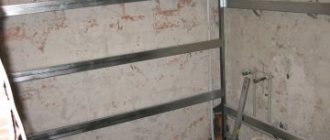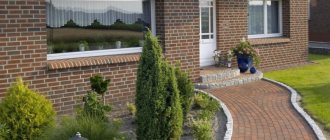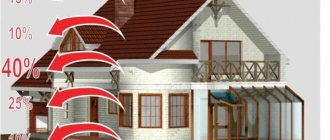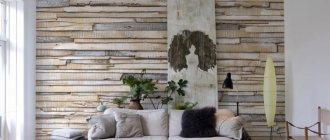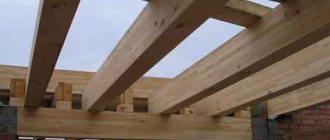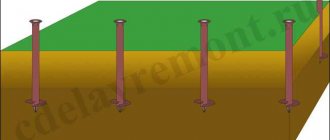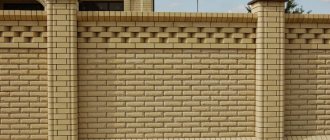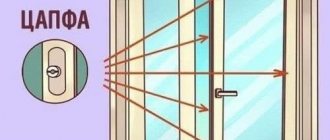Possible causes of dampness
To understand how to eliminate the appearance of damp spots in corners, it is necessary to determine the causes of the troubles that have arisen. There are quite a few of them, but they are all divided into internal and external. In this case, the entry of moisture into the room can be hidden or obvious.
Among the internal reasons are:
- insufficient heating of the room;
- poor ventilation in the bathroom and kitchen;
- frequent drying of washed laundry inside the apartment;
- insulation from inside the room;
- recently carried out renovations, after which the walls have not yet dried out;
- poorly installed windows and window sills;
- pipe leaks in ceilings, walls or floor screeds;
- formation of condensation on pipes and air ducts due to lack of insulation.
External reasons for a damp corner in the house include:
- freezing of walls as a result of violation of the integrity of thermal insulation;
- moisture ingress due to damage to the roof, breakdown of the drainage system or leaking pipes in the attic;
- high humidity in the basement;
- poor quality foundation waterproofing;
- cracks in the walls and unfilled seams;
- voids at the junction of the balcony slab.
As can be seen from the above reasons, the supply of moisture may depend on the floor, the location of the apartment and the wear and tear of building structures.
Effective ventilation against wet walls in any type of room
Usually, at the initial stages of the appearance of condensation, the problem of wet walls is underestimated and left to chance, which leads to serious consequences and high costs in the future.
It is important to understand that if a wall in the house gets wet, then simply opening the window is not enough, since moist air will not be drawn out, especially in the autumn-winter period. Many people use local heaters, believing that this solves the problem. In fact, drying and warming the room temporarily eliminates the consequences, but does not remove the cause of the damage. As a result, the situation repeats itself again and again.
It is necessary to configure both the ventilation system and the heating system at the same time.
However, any additional ventilation system entails one-time costs for delivery and installation; and permanent ones - for electricity and maintenance.
Is there a way to cut down on these expenses? HVAC experts at Solar Fox think so.
How to get rid of dampness depending on the cause
After determining the reasons why the walls in the house become damp, you can determine ways to eliminate dampness on the walls of the house and begin to eliminate the shortcomings. Sometimes you can do this yourself, but more often you have to turn to specialists, especially if it involves working at heights and roof repairs.
Freezing of walls and insufficient heating. Insulation of the room should be done from the outside, inviting industrial climbers for this. Insulation from the inside will almost certainly lead to a shift of the “dew point” to the middle of the building structure. As a result, the flow of moisture through the wall can only increase.
The specialists you contact for help will be able to perform the necessary thermal calculations and determine the thickness of the thermal insulation layer and the efficiency of the batteries. If the heating system operates unsatisfactorily, it can be recommended to increase the heat transfer area of the heating devices without abandoning the external insulation of the walls.
Ineffective ventilation. The absence of a hood with new sealed windows can lead to condensation and moisture settling in the walls. In this case, it is recommended to ventilate the room through slightly open windows. Another effective way would be to install a low-noise fan in one of the exhaust ducts. Electricity consumption in this case will be minimal, and the effect will be noticeable.
Roof leak. If you live on the top floor, start looking for moisture ingress by inspecting the attic or flat roof. A roof leak is often the cause of dampness in an apartment. It is clear that in this case only urgent roof repairs can help. And if you can’t do it yourself, then you shouldn’t save. Call a roofer.
Poor quality waterproofing of the foundation. This reason is found in private houses. The deficiency can only be corrected from inside the basement by introducing injection waterproofing materials. If there is no full basement in the house, you will have to dig out the foundation and use coating or rolled materials.
The junction of the balcony slab and loose joints. The best option is to make high-quality glazing for the balcony and seal the cracks with sealant. Assembly joints between slabs in panel houses should be sealed by industrial climbers who have experience working at heights.
The upper corners of a private house are damp. This happens because the attic is poorly ventilated. Condensation forms and drops roll down the vapor insulation. The field of this moisture penetrates into the room.
Why do the walls get damp?
Wet walls are a disaster for owners. First, the wallpaper peels off, the plaster is destroyed, and mold starts to grow. It is difficult to fight with it, its presence has a bad effect on health. There are several reasons why walls get wet.
Recent renovation
Partitions often become wet after recent renovation work. This is the most harmless reason. There is no need to eliminate it; it disappears on its own over time. The slight humidity inside the apartment after renovation is easy to explain.
The cement mortar used contains water. Poor ventilation, plus damp weather, affects the rate of moisture evaporation. Therefore, worries about humidity are unfounded.
Moisture seeps in from above
External moisture
The walls of apartments on the upper floors get wet as a result of poor quality of the system for collecting and draining water from the roof and poor treatment of seams with waterproofing material. Moisture seeps through microscopic cracks.
Panel buildings are also vulnerable. Violation of construction technology leads to depressurization of the seams between the panels.
Insufficient ventilation
The reason for damp walls in rooms with high humidity is poor ventilation. We're talking about the bathroom and kitchen. The performance of the ventilation is determined by opening the window and placing a piece of paper on the vent grille. If the leaf sticks to the ventilation grille, air exchange is not impaired. If paper falls, the ventilation is not working and requires cleaning.
Related article: How to widen a doorway in a concrete wall
High indoor humidity
Moist fumes penetrate from the basement due to poor waterproofing. Brick has different moisture resistance. Silicate has the lowest performance.
The problem occurs in multi-apartment buildings with basements and poor waterproofing. Sections of the walls near the floor are damp.
Excess humidity appears after installing sealed plastic windows. Periodic ventilation of the room eliminates the problem and removes condensation on the windows.
Wall freezing
Freezing occurs due to poor thermal insulation. It is reduced by insufficient wall thickness, opening of interpanel seams, and cracks.
What to do if nothing helps
If you have tried to eliminate wet walls and the appearance of damp spots, but your actions have not brought positive results, contact the management company. To do this, you must write an application in two copies, one of which must be registered with the Criminal Code.
After this, the management company is obliged to send a specialist to inspect the premises and draw up a report on the presence of moisture. The same act must identify the cause of the dampness and set a deadline for its elimination.
Mold on the walls
The appearance of mold fungi in the house is possible if high humidity (70% or more) has existed for a long period of time. Of the huge variety of types of mold in nature, only a few can appear in a human home:
- Black is the most dangerous variety. Belongs to the fourth group of pathogenicity. Building structures are especially often affected.
- White – rarely forms on walls, only when condensation has been present for weeks;
- Blue - affects wooden walls, leading to rotting of the material from the inside, its cracking.
In addition to its unaesthetic appearance, mold also causes great harm to human health. The reason for this is the saturation of mycotoxins that destroy any type of living tissue. Entry into the body occurs both through direct contact and through the release of spores and their penetration into the respiratory system. If you do not remove dampness from the walls of your home before mold develops on them, the following diseases are possible:
- Skin lesions – mycoses, dermatoses;
- Respiratory tract damage - asthma, bronchitis, cough;
- Digestive system disorders;
- Exacerbation of chronic diseases - nervous system, musculoskeletal system.
The presence of mold has a particularly serious impact on allergy sufferers and people with pulmonary insufficiency.
Preventing dampness
To prevent the walls from becoming damp again, it is necessary to reduce the amount of incoming moisture. For this:
- do not dry clothes inside the apartment, use a balcony or loggia;
- keep the ventilation grilles clean;
- at the lowest outside temperatures, use additional heating devices;
- in a private house, insulate the attic and ensure its ventilation;
- Ventilate the premises more often.
Install a fan with a built-in humidity controller on your bathroom hood. When the moisture content in the air increases, it will turn on automatically.
Remedies
Mold fungi are difficult to remove. In all cases, the final coating will have to be completely removed - wallpaper, plaster, and if the damage is deep, putty to the very base of the wall. The only exception may be a painted surface, since mold has difficulty penetrating a layer of paint, but spreads more strongly over its area.
The safest way to remove mold and dampness from your home is with the help of chemical compounds, some of which are easy to prepare at home:
- Antiseptic primers are special products with a high content of fungicides; with their help you can process the wall to a depth of 0.5 cm;
- Household bleaches - any type containing sodium hypochlorite will do;
- Hydrogen peroxide - 3% composition is used; due to the whitening effect, it is not suitable for treating painted surfaces;
- Potassium permanganate - found in everyday life in the form of a solution of potassium permanganate; used as a mixture - 15 g per 1 liter of water;
- Vinegar and citric acid are effective at the initial stage of mold development.
Even after eliminating the fungus, a characteristic unpleasant odor remains in the room. A simple method to get rid of it is to treat the floors with a baking soda solution. To prepare it, 15 g of the substance is dissolved in 100 ml of water.
Surface insulation scheme if the wall in the apartment gets wet
Many apartment owners are interested in the question of where to go if there is a wet wall in the apartment and what to do in such cases.
In fact, there can be only one solution - to visit a construction company that provides similar services. This will immediately provide several advantages. On the one hand, you will decide what to do when the wall in the apartment gets wet, and on the other hand, you will receive high-quality work that will not require rework in the future. Another important point is that the master has an idea of what to do if there is a wet wall in the apartment, which means he will carry out all the necessary work strictly according to technology. For example, we can give the following algorithm for finishing a section of a wall. For such work, craftsmen recommend using foam plastic or “warm” plaster. All work on wall insulation is carried out using the following algorithm:
- The work site is prepared, namely, it is cleared of dust and debris, after which leveling plaster and primer are applied to it. The base for further work is ready and now you will need to glue the foam onto it, and then secure it with special dowels.
- Each sheet must be treated with an adhesive composition, and then pressed onto the prepared surface and pressed well. It is best to place the sheets in a checkerboard pattern, thereby increasing the strength of the structure.
- Fastening with dowels is carried out around the perimeter, and holes will have to be drilled in the material.
- After gluing and fixing the sheets, the finished finish is covered with reinforcing mesh and the overall structure is plastered. The walls are decorated with paint, and a layer of decorative plaster is applied to it.
The simplest option for wall insulation, which determines what to do when a wall in an apartment becomes damp, is to insulate the surface from the outside using special “warm” plaster. The material is applied to the plaster mesh and then decorated.
Sources of moisture
It should be understood that high humidity appears for a reason.
If you imagine a house as a structure, then several possible sources stand out:
- foundation;
- walls;
- roof;
- plumbing;
- ventilation.
Let's take a closer look at each type of structure, communications, the reasons that can lead to the appearance of moisture, as well as how to get rid of dampness in the house.
Optimal microclimate in the house
Much depends on the indoor microclimate, including the health of the inhabitants. But the structure of the house, the safety of the walls, floors, and ceilings suffer no less from temperature and humidity.
To avoid costly repairs, it is important to maintain an optimal microclimate in the premises. This for humidity is no more than 60% in the winter and 65% in the summer. For air temperature – at least 15°C. It is not difficult to notice a deviation from the norm; dampness is manifested by the following signs:
- Condensation on glass and sections of walls connected to the ceiling;
- Characteristic “wet” smell;
- Swelling of wooden structures; expressed, for example, in poorly closed doors;
- Damp salt and sugar.
At the first sign of high humidity, do not hesitate. If you do not remove dampness from the walls in time, mold will soon form. Removing it will take weeks and may lead to the need for cosmetic repairs. Determining humidity above normal “by eye” is problematic; a simple home hygrometer will help with this.
Note that high humidity has a destructive effect not only on wooden structures, leading to their rotting, but also on stone ones - brick, concrete. Soaked in water, they crumble, a process that accelerates in regions with cold winters. Metal structures suffer a little less, but they are also susceptible to corrosion.
Eliminating moisture due to wall problems
First of all, the existing ventilation systems are inspected and their performance is checked. Check with a lit match or candle. Fluctuation or fading of the flame indicates that the system is working. If the fire does not fluctuate, it means that the hood has failed. Accordingly, it needs to be cleaned. Particularly important is the performance of forced ventilation in the bathroom and kitchen.
Is it worth insulating a corner from the inside?
Owners of country real estate and city apartments prefer to immediately cover the problem area with sealant, putty, or seal it with all kinds of thermal insulation materials. Unfortunately, such measures will only help if the corner is frozen quite a bit, which is rare. You also need to understand that a heat insulator laid from the inside will block not only cold, but also heat. Insulation can only make things worse, since it will cause the dew point to shift to the inside of the wall. As a result, cold air will freeze the wall right through, because the heat insulator prevents the heat from the house from warming up the concrete, brick or wood a little. As a result, the wall material will only begin to deteriorate more intensely, and the problem will be solved in a very short time.
We recommend: Dormer window: what it is, what it is for and why it is needed, purpose
But sometimes facade work is simply impossible to carry out. In this case, it is also recommended to take into account some nuances.
Claim to a judicial authority
The current legislation of the Russian Federation imposes strict requirements on the form and content of the statement of claim.
In accordance with these requirements, the claim must contain the following information:
- full name of the court to which the claim will be filed;
- full information about the plaintiff. The surname, first name and patronymic, details of the identity document, registration and actual residence address, as well as contact telephone number are indicated. If a legal representative acts on behalf of the plaintiff, then similar information is indicated about this representative;
- all information known to the plaintiff about the defendant;
- a detailed description of the actions of the defendant that led to the violation of the legal rights and interests of the plaintiff;
- cost of claims with detailed calculation;
- the requirements that the plaintiff seeks to satisfy;
- evidence confirming the legitimacy of the requirements put forward;
- List of documentation attached to the statement of claim.
The statement of claim is sealed with the handwritten signature of the plaintiff or legal representative with a transcript and indication of the date of signing.
We note that the legal representative acting on behalf of the plaintiff must have a properly executed power of attorney confirming the authority of this representative to perform the necessary actions.
If the cost of the claim does not exceed 50,000 rubles, then the claim can be sent to the magistrate’s court. If the value of the claim is more than 50,000 rubles, then the claim is sent to a court of general jurisdiction.
Since claims against management companies relate to claims for the protection of consumer rights, the state fee for filing a statement of claim is not charged, provided that the amount of claims does not exceed 1,000,000 rubles.
The magistrate's court is given 1 month to consider the claim on the merits and make a decision, and the court of general jurisdiction is given 2 months.
ATTENTION! Look at the completed sample claim to court against the management company:
What to do
Having found out the reason why the walls get wet, the question arises of eliminating excess moisture.
If such a situation arose after renovation, then it is enough to ventilate the rooms more often. If this is a cold period of time, then it is important that the room is warm enough.
If the batteries are not enough, you can use additional heaters. When the problem lies in ventilation, you can try to remove foreign objects that interfere with normal air circulation.
Insufficient waterproofing is a more complex situation. Eliminating the problem consists only of finding the area where the water comes from and isolating it well. The main source is seams on the outside of the house. This task should only be solved by specialists.
